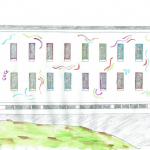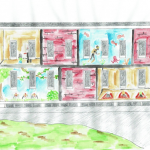Just as I began my internship with Metris in September 2018, I also embarked on my engineering studies senior capstone design project. Our group had to design an art installation for the exterior of the Acopian Engineering Center at Lafayette College. Our goal for the project was to create an installation that could help Acopian and the engineering department feel more inclusive and interdisciplinary. At the time, I was still finding my footing at Metris, but based on what I knew so far, this project seemed likely to be a perfect converging of both of my majors (engineering studies and studio art) and my work at Metris. I just wasn’t sure what exactly that would mean.
As I sat in class on the day that my professor first introduced the capstone project, my mind immediately began considering the possibilities that it held. I was thinking big and sculptural. I liked the idea of incorporating plants into the design.

Acopian Engineering Center: east facing exterior wall
It took all of one day for me to discover that there was going to be design tension within my group. My plants were having a tough time competing with a mural idea. Other members of the group thought a mural would be the easiest and most effective solution. It is colorful and has innumerable choices for imagery. In fact, one group member generated an idea for a “cutaway” mural, where the painting would depict the goings-on in a series of classrooms in Acopian, ranging from the ordinary (students fiddle with robots) to the ridiculous (a room filled with trees and wildlife). I had reservations about the idea, including the technical feasibility of painting such a complex image in the spaces between the windows on our designated wall. Regardless, all of our early brainstorming ideas faced an uphill battle; at this point we were not sure that any would survive the process.
As we challenged ourselves to consider the stakeholders and decision makers in our project, I immediately thought back to an opportunity I had in my internship. Early in the semester, I accompanied the Metris team on a stakeholder analysis meeting to discuss which community members should be consulted with for the creative sector economic analysis that Metris is completing for the Cultural Coalition of Allentown (CCA). In preparation for the meeting, someone from the team briefed me on one method of identifying stakeholders: generate the names of as many relevant people, organizations, institutions, etc. as possible and then plot them on a graph of interest vs. influence. This method helps promote the inclusion of voices that may often be ignored, such as artists (especially artists of color and those belonging to marginalized groups) who may have high interest in the creative sector economic analysis, but low influence.

Interest vs. influence at a Metris stakeholder analysis meeting
Throughout my time at the internship, I have seen Metris put immense emphasis on the importance of including a diverse group of community voices to shape their projects. I thought about how this would apply to my capstone project. As an artist myself, it would be so easy (and frankly, a ton of fun) to generate my own design for the art installation with minimal collaboration with community members. And undeniably, there is value in my group’s design ideas: we come to the table with experience as students, engineers, and artists, who know firsthand the successes and failures of the engineering culture that Lafayette has cultivated. However, we are by no means the only experts, nor would we be the only ones affected by the implementation of our design. We decided that we wanted community participation in every step of the design process, from problem definition to generation of the design itself.
This was a challenging task. I thought there was design tension within our group; that was nothing compared to the community at large. The first interview I conducted was with a panel of students with engineering and art double majors. As much as I had hoped they would not, their responses successfully fulfilled a bunch of engineering stereotypes. The three students shared interest in a colorful mural with imagery of gears, light bulbs, and polymers denoting the various disciplines housed within Acopian. Or, a mural that depicts research that students and professors are currently working on. There was talk of incorporating moving parts as well. Their definition of our project goal was to make Acopian a better space for them to learn and study. Their design was meant to liven the building and entertain.
My next interviews were with two art department professors. Unsurprisingly, they defined our goals in a vastly different way. For them, the hope was to connect programs across campus through art. They saw this as an interdisciplinary opportunity to build stronger community relationships. Almost immediately, both professors told me that we needed to scrap the mural idea. One suggested painting smaller panels with abstract imagery that could connect to themes of tech or biology and backlighting the panels. The other professor suggested a light installation with changing colored light patterns. The patterns could even carry some significance for our campus, à la Leo Villareal’s Bay Bridge installation, “The Bay Lights,” inspired by San Francisco traffic patterns. In our conversation, he went so far as to say that engineers cannot be trusted to make creative decisions! Artists need to complete a design and then bring it to the engineers to figure out the technical issues. I left each interview feeling more confused. The engineers are too obvious and literal in their design; it doesn’t have mass appeal. The artists don’t want to collaborate with the engineers. One art professor practically tried to sell me his artwork for the side of the building (but alas, the capstone project did not give me license to deal on behalf of the school; this is way above my pay grade).
As it turns out, the process my capstone group was working through already has a name and a host of well-known challenges. My exposure to Metris’ work has (at first, unknowingly) led me to a practice known as “community-engaged design.” This approach centers on the idea that community members must be integral in the design process in order to create more sustainable and equitable solutions. Rightfully, much of the literature addresses community-engaged design through a racial, class, or gender lens. In an article on design equity, Professor Kofi Boone writes that the practice looks to decrease “the inherent inequality in access to information and resources in typical relationships between designers, planners, and the communities they serve.” Toni Griffin, a practitioner, further explains that the ultimate goal of community-engaged design is to “build in local ownership of the process, outcomes, and benefits […so that] community stakeholders become empowered and attain an agency to articulate and shape their needs in their own voice.” However, achieving this goal requires a great deal of time and effort. It also surfaces a lot of design conflict.
Ultimately, my capstone group decided to research and submit three design alternatives rather than one. In our report we weight the benefits and drawbacks of each. Although this felt in some ways like the only option based on our time constraints, I am left wondering if this really was the best solution or if it was just the easiest. Yes, we put in the work to conduct all the interviews, gather information, and make the community feel heard. But beyond that, I can’t help but feel that putting forth three options might be a bit of a cop out. The purpose of community-engaged design is to consult the community and then turn their input into a design. What I didn’t consider at the beginning of the process, though, is that we would have to make tough choices about the direction we steer the design in. The feedback we got from the community was so diverse that it would be impossible to incorporate all (or even most) of their ideas in one design. This means we have the responsibility of choosing what to include. To me, this translates to the responsibility of choosing whose voices in the community matter most and who will end up with ownership of the project. This is a task I really didn’t feel comfortable with.
- Alternative 1: a vertical garden
- Alternative 2: a light installation with neon tubing inspired by Stephen Antonakos
- Alternative 3: a “cutaway” mural
Despite my reservations about our design outcome, we laid important groundwork for an Acopian art installation. Maybe if we had more time, we could have better negotiated between the diametric groups to resolve some of the creative conflicts that arose. Either way, this semester has given me a glimpse into the potential for an art installation to encourage real change in and around our engineering educational culture. The one thing every interviewee agreed on was Acopian’s need for a project like this. I hope that we have made the most of our abilities so that future engineering studies students may carry this project forward with community in mind.



